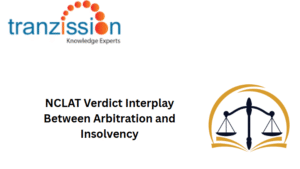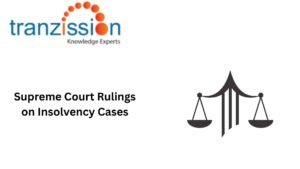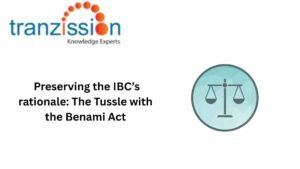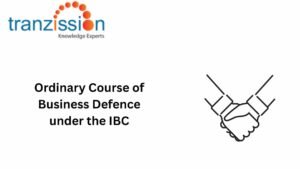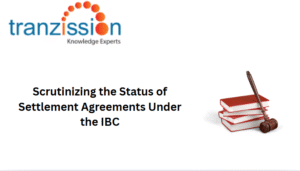
Role of asset reconstruction companies in insolvency proceedings

Table of Contents
The Insolvency and Bankruptcy Code, 2016 (IBC) aims to revive, restructure, or rehabilitate insolvent companies. Insolvent companies face several legal and financial issues, which they overcome with the aid of other professionals and entities. Asset Reconstruction Companies (ARCs) are one of the many options available to them.
What Are Asset Reconstruction Companies (ARCs)?
Asset Reconstruction Companies are a special type of financial institution that buys the debtors of the bank at a mutually agreed value and attempts to recover the debts or associated securities by itself. To understand this in more detail, let’s go over the points below:
Read more : Offences and Penalties under IBC, 2016
Definition and Objective:
Asset Reconstruction Companies are financial institutions that buy and manage distressed assets like loans or non-performing assets (NPAs) from banks and other financial institutions. Their primary objective is to resolve NPAs and ensure economic stability by facilitating the cleanup of banks’ balance sheets and helping them focus on their core banking activities.
Legal Framework Governing ARCs:
The Securitization and Reconstruction of Financial Assets and Enforcement of Security Interest (SARFAESI) Act, 2002 provides the foundation for Asset Reconstruction Companies to acquire and manage NPAs and undertake asset reconstruction activities. The Reserve Bank of India (RBI) regulates ARCs under this Act by guidelines for their operations and registration requirements. ARCs are permitted to act as “resolution applicants” under the IBC, which means that they can submit resolution plans to revive distressed companies undergoing insolvency proceedings.
Legal Status of ARCs Under IBC
ARCs operates in a highly regulated environment and are required to adhere to strict RBI guidelines and with the necessary legal provisions.
Recognition of ARCs as Resolution Applicants:
Section 29A (j)(iii) of the IBC states that a financial entity acting as a resolution applicant under the Code cannot be a related party and explanation – II of this section recognises an ARC as a financial entity for the section.
Role in the Corporate Insolvency Resolution Process:
As a resolution applicant, Asset Reconstruction Companies can participate in the corporate insolvency resolution process (CIRP) by submitting resolution plans to the Committee of Creditors (CoC). As per RBI Guidelines, Asset Reconstruction Companies cannot exert substantial influence or control over the corporate debtor once they acquire distressed assets during CIRP. Therefore, they are prohibited from maintaining significant control over the insolvent company for an extended period so they cannot manipulate the process to benefit themselves at the expense of other creditors.
Challenges in Legal Recognition:
Initially, there were several uncertainties regarding whether Asset Reconstruction Companies could act as resolution applicants under the IBC because of inconsistencies between the IBC and SARFAESI, which may lead to confusion about their scope of operations. According to the regulatory changes by the RBI, this issue was clarified. ARC can, thus, participate as resolution applicants under certain conditions, including having a minimum net-owned fund and a board-approved policy
Read more : Balancing environmental claims during CIRP
Functions of ARCs in the Insolvency Process
Asset Reconstruction Companies has a proactive role in recovering assets from NPAs. As per RBI guidelines, ARCs balance the interests of banks, investors, and borrowers.
Acquisition of Distressed Assets:
Banks and financial institutions identify loans that have become non-performing, which means that the borrower is not paying as agreed. Once the banks transfer the distressed assets to ARCs and Asset Reconstruction Companies acquire distressed loans from financial institutions and banks at discounted rates.
Resolution Plan Submission:
On acquiring distressed assets, ARCs actively manage and restructure those assets through various strategies like debt restructuring, asset liquidation, and legal action. This aims to maximise recovery value and potentially enable the distressed company to regain financial stability. As a resolution applicant under IBC and submits viable resolution plans to the insolvency professional to propose a way to revive the distressed company.
Facilitating Asset Reconstruction:
ARCs use a variety of methodologies to help borrowers recover financial stability. They can negotiate with borrowers to restructure their debt by lowering interest rates and extending repayment periods, This can make the debt more manageable and help borrowers avoid bankruptcy. ARCs can also take over the management of distressed assets if rehabilitation is not feasible.
Collaboration With Creditors:
ARCs work with creditors to create a unified approach for debt recovery and resolution. They collaborate with creditors by purchasing NPAs from banks, then actively working to recover as much debt as possible through various means like debt restructuring.
How ARCs Contribute to the Insolvency Ecosystem
ARCs have an important role in the insolvency ecosystem in resolving NPAs and improving the financial system:
Reduction of NPAs:
By acquiring NPAs from banks or financial institutions, then attempting to recover their dues or restructure the loans. This clears the balance sheets of such entities which allows them to focus on their functioning. Hence, they use their expertise in asset management to improve governance during the resolution process.
Enhancing Liquidity:
Acquiring NPAs frees up capital on the bank’s balance sheet, allowing them to provide fresh loans and improve their liquidity while simultaneously attempting to recover value from the distressed assets through restructuring or resolving distressed assets.
Promoting Economic Growth:
ARCs contribute to economic growth in many ways. They relieve banks of the burden of bad loans and improve their financial health, which is important for maintaining credit flow in the economy. It indirectly promotes economic growth by reviving distressed businesses and preventing their liquidation.
Case Studies: ARCs in Action
JM Financial ARC and CIRP:
In Yavar Dhala v. JM Financial Asset Reconstruction Company Ltd., the National Company Law Appellate Tribunal held that ARCs can participate in the CIRP as a resolution applicant, which means that they can submit a plan to restructure a debt-ridden company’s liabilities and potentially take over its assets to revive the company and maximizing value for creditors.
Edelweiss ARC’s Role:
Edelweiss ARC has a crucial role in distressed asset resolution under the IBC by actively acquiring and managing distressed assets from banks and other financial institutions, and attempts to revive distressed companies through restructuring and providing the necessary capital to facilitate their revival.
Phoenix ARC’s Success Story:
Phoenix ARC filed an application under section 7 of the IBC on July 7, 2018. The CoC was formed on May 22, 2018, with Pheonix ARC and State Bank of India as its members. The resolution plan submitted included the cancellation of all pledges, liens, and other encumbrances on fixed deposits, the fixed deposits would revert to the corporate debtor, and the bank guarantees issued for the fixed deposits would no longer be legally enforceable.
Challenges Faced by ARCs in the Insolvency Process
Being a resolution applicant under the IBC and legal restrictions, ARCs face many challenges due to the complexity of NPAs and the lack of readily available market data, including regulatory hurdles, asset valuation issues, and lack of investor interest, which make the entire process time-consuming.
Regulatory Hurdles:
Section 29A of the IBC permits ARCs to act as resolution applicants, but SARFAESI prohibits them from engaging in other businesses. This inconsistency adds to the legal ambiguity of ARCs.
Asset Valuation Issues:
There are many difficulties in accurately valuing distressed assets as there may be complex asset types, like real estate, machinery, intangible assets, etc. each requiring specialised valuation methodology which can be challenging to apply accurately. There is also an absence of clear and standarised valuation guidelines for distressed assets can lead to inconsistencies in valuation practices across different ARCs. If an ARC overpays for an asset, its ability to recover the invested amount through asset realisation is reduced, which impacts the recovery rate.
Lack of Investor Interest:
There is a lack of investors or buyers in certain distressed sectors can impede ARCs resolution efforts. This may be because ARCs have demonstrated a poor record of recovering significant amounts from distressed assets, leading investors to doubt the viability of investing in them. As ARCs prioritise debt restructuring over business revival, this limits their ability to fully turn around distressed companies and maximise value for investors.
Time-Consuming Processes:
Adhering to the stipulated timelines within the IBC for resolving insolvency cases can be challenging due to legal complexities and financial issues. The resolution plan must also approved by the CoC and the Adjudicating Authority. However, the approval may be delayed because of judicial bottlenecks and stakeholder disagreements.
Recommendations for Strengthening ARCs in the Insolvency Framework
Policy and Regulatory Reforms:
Policy and regulatory reforms should focus on enhancing ARCs operational efficiency and address the issues related to asset valuation, transparency, and governance. By introducing reforms that simplify and expedite the regulatory approvals required for ARCs to acquire stressed assets, including faster due diligence and improving ARCs participation in CIRP.
Enhanced Collaboration:
It is recommended to foster collaboration between ARCs, creditors, and resolution professionals to expedite insolvency resolution. This can be done by establishing a centralised platform where all parties can access relevant financial and operational data of distressed companies, promoting informed decision-making.
Leveraging Technology:
Adopting artificial intelligence, predictive modeling, and data analytics ARCs can improve asset valuation, debtor, and debtor risk assessment, and predict market fluctuations. By providing a centralised platform, real-time access to the required documents for all stakeholders, and facilitating transparent and efficient online auction platforms, the parties involved in the insolvency process will be able to make more informed decisions.
Emerging Trends in ARCs Under IBC
It is important to introduce pre-pack insolvency processes to large firms or introduce a similar “creditor-led resolution” mechanism under the IBC. Such processes are also faster and cheaper than formal proceedings and offer confidentiality which can preserve the company’s value. Pre-pack insolvency processes can create new opportunities for ARCs by allowing them to participate in faster, more streamlined debt resolution processes for distressed companies where companies can actively negotiate and acquire stressed assets at potentially viable valuations. ARCs have a potential role in managing international distressed assets under evolving cross-border insolvency laws.
Conclusion
ARCs have emerged as pivotal players in India’s insolvency ecosystem. They have specialised skills in asset evaluation, restructuring, and recovery mechanisms, which are essential for maximising value from distressed assets during insolvency proceedings. Thereby the role of ARCs proved to be indispensable in ensuring that the distressed are efficiently managed and productive resources are optimally utilised, ultimately contributing to overall economic growth.

